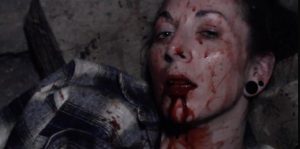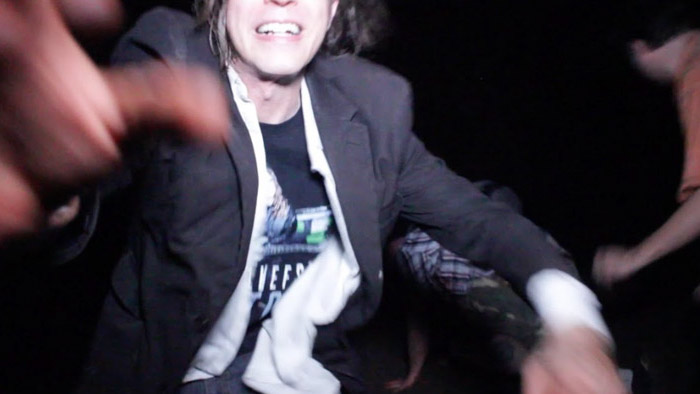
Drew Fortier’s feature debut, Dwellers, collapses the distance between storyteller and story. The film recalls The Blair Witch Project for its inventive use of blurring the lines between fact and fiction. Pulling triple duty as writer, director, and actor Fortier plays a lightly fictionalized version of himself named Drew. He has promised Megadeth bassist David Ellefson (who served as producer) a documentary about the homeless.
Running short on time and money, Drew enlists his friends, Doug (Doug Esper) and James (James L. Edwards), to shoot a movie in a weekend. So the trio venture down the labyrinthian tunnels that burrow beneath the city’s surface to uncover why the homeless population living there, “dwellers,” is disappearing. But eventually, they are thrust into a mystery involving something nefarious that calls the tunnels home.
Structured around a framing narrative that sees James interrogated by the cops about the disappearance of his two friends, Dwellers oscillates between CCTV footage of the interview and the found footage of the supposed documentary. The “thing” at the center of it all is ill-defined, as Fortier often embraces darkness to obfuscate the creature hunting them. Presumably because of budgetary issues. So, instead of teasing out the creature feature that the film attempts to morph into, once the group ends up in the tunnels, it devolves into shaky-cam galore. The three scream their way through 40 minutes or so — of an already short 80-minute feature — without the audience able to decipher what exactly is going on.

“…these creatures move about in the darkness, afraid of the light that Drew’s camera emits.”
It eventually becomes clear that these creatures move about in the darkness, afraid of the light that Drew’s camera emits. Because of this conceit, every notable kill is showcased in pitch-black, as viewers are left to piece together what exactly happened. This could’ve worked as a strength since Fortier often cuts back to the interrogation room, suggesting the compelling alternative that the creatures are just a manifestation of James’s psychological break, teasing out a narrative possibility that is never fully developed.
Instead, Dwellers cannot decide if it wants to be a psychological thriller or schlocky B-horror. The results end up somewhere in the middle, as the director doubles down on vicious kills, in the end, jettisoning any sense of nuance that could’ve been mined from the interrogations. By the time a mysteriously suited figure, looking like a reject Agent Smith, shows up to suggest a government cover-up, it’s obvious that the film nor the filmmaker have any idea what they want to accomplish, throwing anything at the wall. That, maybe, could’ve been forgiven if it weren’t for the borderline incompetent filmmaking.
Despite these problems, the film deploys an enticing extratextual layer, blurring factual portraits of the behind-the-scenes creative team, something that numerous other found footage films have also attempted. But, here, it creates a sense of verisimilitude, inviting viewers to consider the overlap between actor and character. However, that sense of world-building is quickly lost as the film is ultimately an amateurish attempt at found footage horror, unable to synthesize a compelling set-up to create a meaningful or even entertaining horror outing.
While Fortier, Esper, and Edwards try to shade in their stock characterizations, the three continually suffer from wooden line readings and awkward reactions to an already underdeveloped script. Despite the pedigree associated with the film — Fortier is an accomplished musician in his own right and even has co-written a novel with Ellefson — Dwellers cannot help but feel rushed. Oddly, this enacts the film-within-a-film’s hurried timeline while failing to capitalize on its inherent potential.

"…creates a sense of verisimilitude, inviting viewers to consider the overlap between actor and character."


